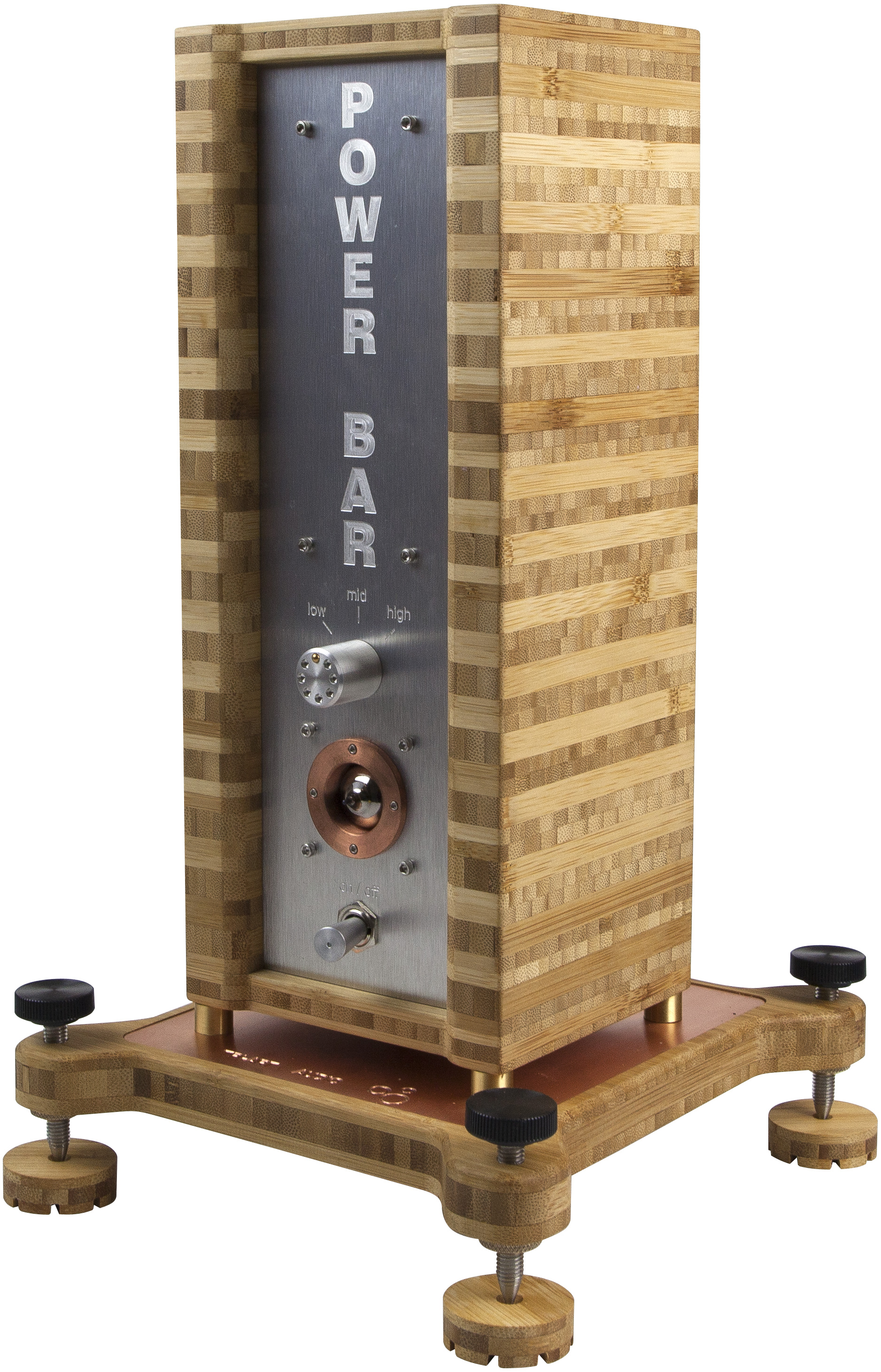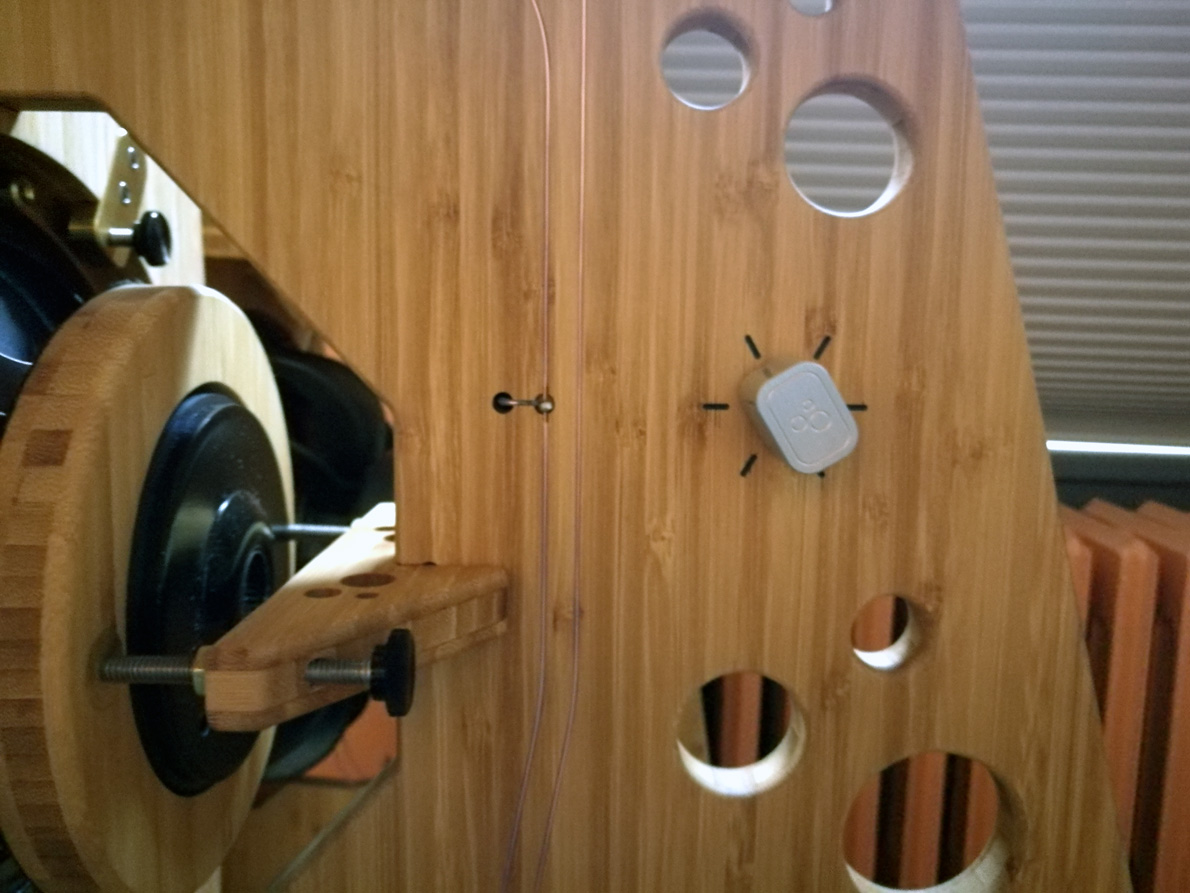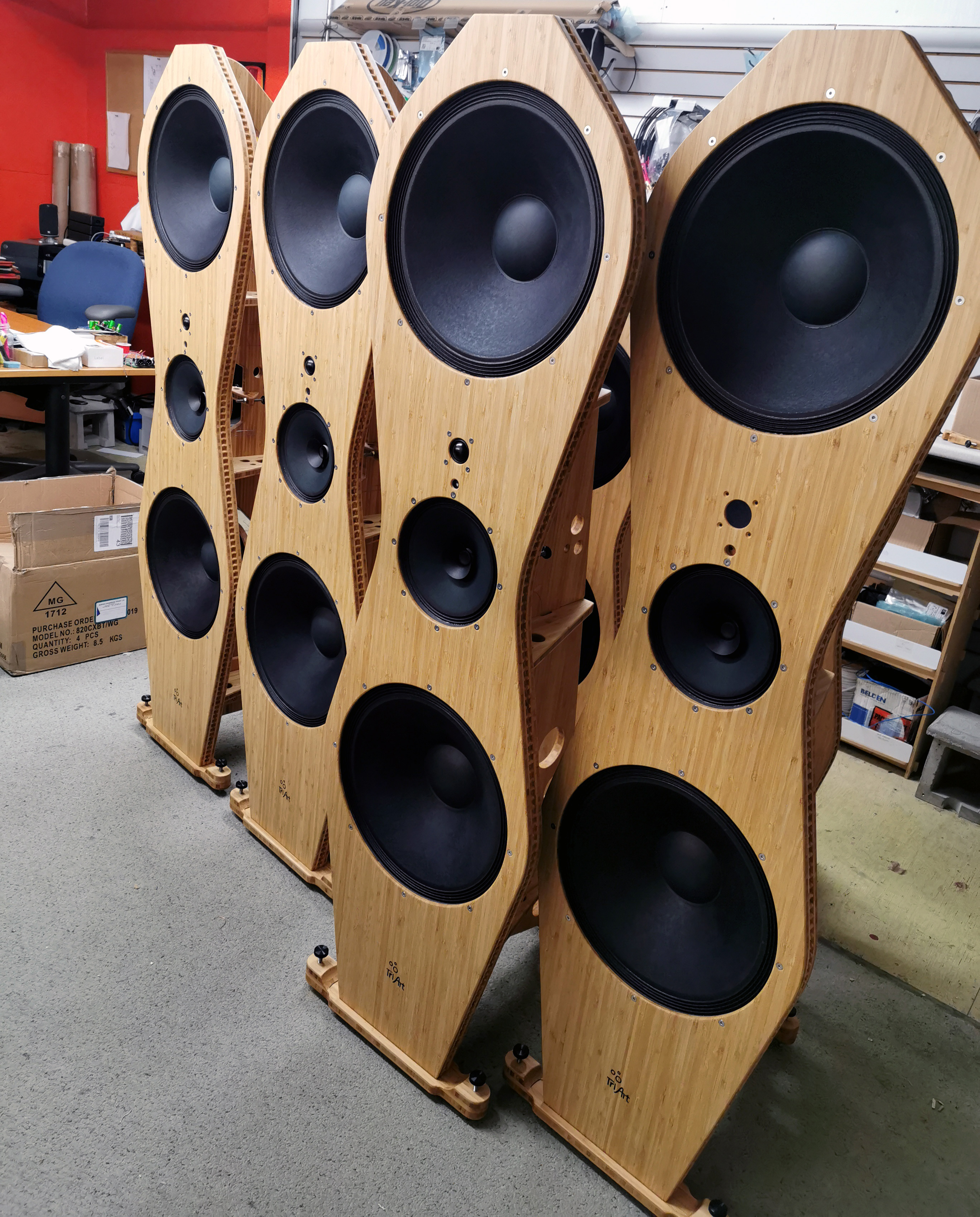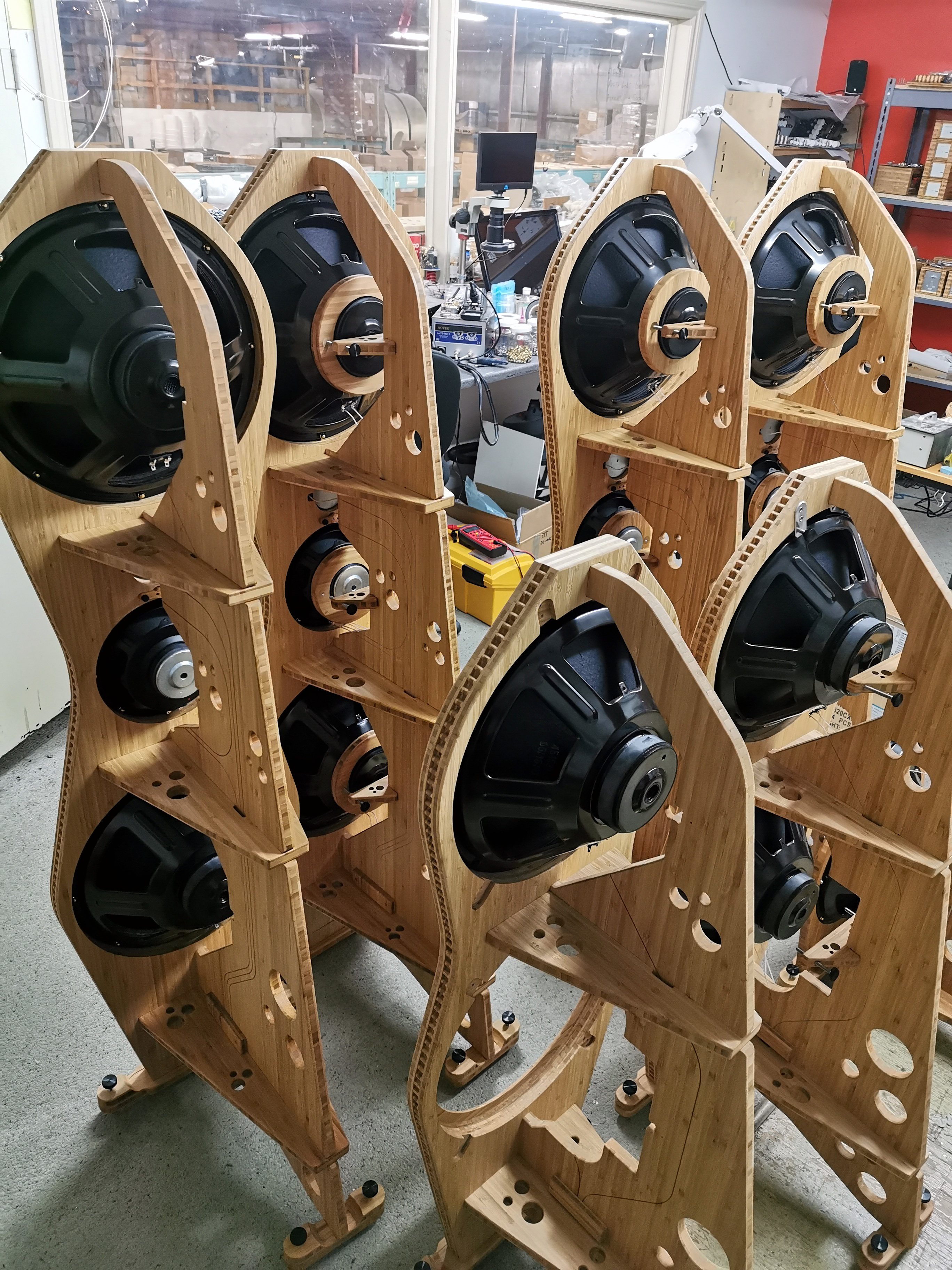System configurations
It should be obvious that the 5 Open is not to be stuffed into a corner like an Audio Note speaker, nor plopped against the front wall. This speaker needs some room to breathe. I had the 5 Open six feet from the head wall and a minimum of two feet from the side walls. I sat at my typical 12 feet from the speakers. Toe in was slightly to the outside of the respective ear. With this setup the soundstage scale was generous and the sound field as deep as with any speaker (panel, dynamic or horn) that I have used.
The following types of amplification can be used with the 5 Open speaker system. Driving the entire speaker with two channels (requires use of the thin wire jumpers; if used I strongly recommend replacing with higher end wire) can be done with a receiver, but preferably an integrated amp or separate preamp and stereo amp or mono amps. It would be a pity, however, to acquire a speaker like this and not fully realize the benefits of the attenuated full range driver. Thus, the goal should ultimately be to provide the functional equivalent of four channels of amplification for input to the crossover without the jumpers, in one of the following permutations:
- Integrated amplifier’s outputs doubled via bi-wiring;
- Multi-channel amp with at least 4 channels of amplification (Note: Theoretically 6+ channels can be summed to provide 2 at higher power, e.g., 200wpc, and 2 at lower power, e.g.,100wpc);
- Two separate stereo amps (e.g., stereo tube and stereo SS);
- Four mono amps (requiring 2 matched pairs, or 4 identical)
The benefit of using four channels versus bi-wiring is the flexibility to select different amplifiers for bass duty and full range duty. Here are some of the system configuration options that were available to me based on the equipment in my room at the time of the review, starting with systems not using the Tri-Art Pre-Amplifier and moving to ones that would use it. The source used throughout the review period was the Small Green Computer sonicOrbiter and SONORE Signature Rendu SE systemOptique:
- Eastern Electric Minimax Tube DAC Supreme and four channels selected from the following stereo amps: Tri-Art 60W Amplifier, amp output of the Kinki Studio EX-M1+ Integrated Amp, or Pass Labs XA200.8 Monos. [Note: in configurations using a DAC where the DAC does not have a volume control (attenuation), then you must use software volume control! Never send an unattenuated signal directly to the amp(s). Often, I choose to have the DACs output at 100% and control listening level from the software volume control, in my case Roon’s user interface.
- Exogal Comet DAC with the same selection of amplifiers to achieve four channels.
- Tri-Art Pre-Amplifier inserted into the chain after either DAC, with selection of amplifiers listed above.
Notice that this gives me many options to select from. Which would be the best in absolute performance terms? That would have to be discovered through the more tedious process of building every combination of system. There is no other way to determine the outcome. Guesswork in that regard is not accurate. As a reviewer who must move on to new equipment and systems, I do not have the time to build every permutation of systems for review. The owner who wishes to discover all the options available to him/her could do so.
In summary, variants of this system yielded terrifically gratifying listening experiences. Though the core of this system’s amplification and speakers were at the $12K mark, the sound quality was not typical for a moderately priced system. I found much to admire about the interplay of the Tri-Art Pre-Amplifier and Amplifier in use with the 5 Open. I did swap the amps, putting the Class D on the full range driver and the solid-state amp section of the Kinki EX-M1+ on the bass, but the EX-M1+ was richer and better suited to the full range driver. With the Tri-Art Amplifier on the bass I could adjust the tube gain settings and plump the bass to whichever degree suited me.
Powering up the 5 Open big time
One of the chief criticisms of OB designs has been insipid bass. Like vintage Quad speakers, one had to bid farewell to frequency extension in order to gain the magical midrange. In the case of the OB speaker, it was assumed LF would suffer. Attempts have been made to bridge the gap between OB and cabinet speakers, one of the most notable being the late Siegfried Linkwitz’s designs. Yet, they use a quasi-cabinet design in order to gain ground on the bass output.
No more shallow bass worries with the 5 Open! In this respect the clever full range attenuation feature of the crossover is an open baffle game changer. Tri-Art is not the only company to utilize attenuation in such a way; I had one of the PAP-C1 Analogue Active Crossovers in my home while the flurry of reviews of the Trio15 line was unfolding. Alas, because of time constraints, and because it requires four channels of amplification, I never used it.
Realizing what the 5 Open can do, and that I had in my hands a similar device for the Trio15 Horn-1, which I admire, I realized that I gave the PAP-C1 short shrift. I quickly contacted PureAudioProject and asked to have one sent back to me. The power to fundamentally alter the Trio15’s bass to mid/treble balance similar to the 5 Open was not going to escape me! A follow-up to the PAP-C1 Review is underway.
This segment was supposed to discuss the power of the bass of the 5 Open, so now I will. It was not that long ago that I had the dreamy Legacy Audio Valor Speaker System in my room. A transducer of seeming unlimited power and LF presence, there has been no equal to the Valor. While not nearly as stentorian as the Valor, the 5 Open captures a respectable amount of bass presence. The simple adjustment downward of the Full Range driver is all that is necessary.
I am not suggesting that for a truly subterranean experience, or for prodigious HT application, the 5 Open would not benefit from subwoofers. Just as even the amply arrayed Legacy Audio Whisper with its four 15” woofers per channel still benefits from the additional two 15” drivers of the Legacy EXTREME XD Subwoofers, so also the foundational LF dramatically improves with the addition of these subwoofers to the 5 Open. Is there such a thing as too many 15” woofers? Yes, in terms of pursuit of absolute cleanness, as with the addition of these new drivers there is a toll taken on resolution. However, the advantage to be heard is the far more powerful and easeful frequencies from 25Hz down. The only way to achieve that combination of ease and force is by adding cumulative driver inches.
Those who are purist may opt for the 4 Open, which leaves off the upper 15” driver. The coherence between the remaining drivers is bound to be superior, however presence will suffer. To achieve the added presence, I accept the effect of localization of the two woofers, and to improve their sound in relation to the other drivers I place a drink coaster behind the rear foot of the speaker, raising it about ¼”. One of the most pleasurable, impactful means of dialing in a big speaker with upper and lower bass drivers involves this slight forward baffle tilt. Just as speaker positioning can center the phantom image, so also this forward baffle slope locks in the tonal balance between the drivers top to bottom. Tri-Art may not appreciate my doing this, but the benefit is not disputable in my opinion. The presence of the 5 Open increases in a pleasing way as it is tipped slightly forward.
Can a passive speaker outdo an active speaker?
I could not resist building the most irrational, unlikely system, featuring the finest amplification with the shortest signal path. With the source for all these systems previously delineated, I used the Exogal Comet DAC with Plus Power Supply, Schroeder Method XLR Clarity Cable ICs (2m), Pass Labs XA200.8 Mono Amplifiers (a whopping $47K!), bi-wire Clarity Cable Organic Speaker Cables, Tri-Art’s B Series Speaker Cables and .5m Jumper Cables for the 5 Open’s crossover Sub-Bass and Bass outputs; and Clarity Cable 1m Speaker Cables as jumper cables for the crossover’s Full Range outputs.
This system is grossly imbalanced, obscenely disproportionate cost-wise. So, why build it? One does not learn the outside capabilities of products by building boring, homogenous systems. The most interesting systems I build are the ones that push the limits either downward or upward. Without disrespect to Tri-Art, this rig is obviously a downward reach for the XA200.8, which is worthy of the finest gear I can imagine. It is also obviously an enormous boost upward for the 5 Open. What could possibly be learned by such a combination of amplifier and speaker? A lot, actually.
Very few audiophiles subscribe to the “max out the amplifier” method of system building. These “amp first” fans purposely skew the funding not toward the speakers, but the amplifiers. That is not to say they use junky speakers, but attempt to use outliers that with some amplifier TLC could do a great impression of speakers costing multiples more. It seems counter-intuitive to spend nearly ten times the amount on the amps as the speakers. However, the results are stunning!
The quality of the amplifier has pervasive influence upon the system’s quality, far more than the average audiophile knows. Speakers are wrongly credited for much of the captivating nature of the sound reproduction, when amps should be credited. I wanted to see if a passively crossed open baffle speaker could get close to the refinement, definition, depth of field, and presence of a similar speaker (the PAP Trio15-Horn1) that was actively crossed. With the Kinki studio amp channels and Tri-Art Class D amp there was some equivalency, but the Trio15 Horn1’s actively crossed system stood out clearly.
Not so with the monstrous Pass Labs Monos and the passive 5 Open. Straight up, the 5 Open was more defined and with better tonality than the Trio15-Horn1. Now, a word for those who rush to judgment when reading such results – don’t jump to contusions by asserting that I said the 5 Open outperforms the Trio15-Horn1 holistically. I am not saying that, but rather that these two speakers with different crossover technologies are capable of swapping places. In previous comparisons between speakers in regards to active and passive crossovers I had concluded that, all things being as close to equal as possible, the active version wins. However, I also cautioned that results are dependent upon the ancillary components and cables. The result obtained with the Pass XA200.8 Monos and the 5 Open confirms that, at least well enough to me. If you want to compare these speakers with amps of nearly $50K and an assortment of lower end amps in an effort to dispute my finding, feel free. I have not yet run the XA200.8 Monos with the active crossover and PAP Trio15 Horn1. Would it be a shock if it then reasserted itself in terms of resolution? From what I have learned about actively crossed speaker systems, likely not. However, the $5K question would be whether the actively crossed open baffle speaker was worth the additional five thousand dollars.
Another conclusion is that while, typically, four channels of amplification for the 5 Open will outperform, it is dependent upon the selection of amps. I would try all possible combinations of four channels available, including bi-wiring stereo amps. While in all likelihood more closely matched amps in such a comparison would yield a result favoring the four channels of amplification, something is learned each time an alternative setup is pursued.
Finally, I encourage those who are running lower-power amps (i.e. SET) or Class D amps to compare any larger solid-state amps they can bi-wire to their separate four channels with the aforementioned amps. It is possible that a powerful, high quality, though not extremely high priced, solid state amp bi-wired could challenge these others. If I had a SET amp, Class D and SS amp on hand, I would try them all in all the permutations. The attenuated full range driver might revise assumptions about what amplifier should obviously be used for the bass or full range. It is that kind of exploration that leads to superior systems that will be profoundly gratifying. One may find a strong second-best result that would merit hearing occasionally as a departure from the winning combo. When the variable of select speaker cabling for each amplifier is added, some interesting results could be obtained.
Step aside… Let’s hear a soundtrack, Daniel Pemberton’s 2015 musical score for The Man from U.N.C.L.E. Have you grown tired of the big orchestra and heavy synth movie soundtracks? Then perhaps you will agree with me that this stripped-down series of pieces featuring lead flute and light strings is a perfect complement to a “stripped down” open baffle speaker. Instead of attempting to generate big SPLs, I sat back and relished the delicacy of the 5 Open. With the complement of drivers, including the miniscule super-tweeter, the use of silence, decay of instrument notes, and the dynamic contrast between the soft strings and at times heavy drums, was gratifying.
The at times aggressive flute work by Dave Heath on the bass flute, seen on a 1:18 YouTube video clip posted by Heath, elicits admiration for the creativity and skill of the soundtrack. I like hearing the contrast between “Out of the Garage” with its propulsive flute work and “The Drums of War,” where an assortment of drums builds to a climax. I pay attention to the 5 Open and how even the lowest notes of the bass can be refined with adjustments to the system. On pieces such as this, and Paul McCartney and Wings’ Live and Let Die, a system will reveal how good it is at handling congested passages, and in this respect the 5 Open is commendable not in small part to its being an open baffle design, ridding itself of the unnecessary reverberation of a cabinet.
Aside from the wildly imbalanced build out, how did the variants of these systems fare? The Exogal comet was leaner (in comparison only; it is not a thin sounding DAC) and more refined than the Eastern Electric DAC, and this streamlined system had more crisp leading edge and seeming quickness in transients than when the Tri-Art preamp was inserted into the system. The Tri-Art Pre-Amplifier offered additional chameleon-like adaptability to manipulate the tonal palate from top to bottom. With both gain settings to select from on the preamp as well as the power supply, multiple adjustments are possible. The toll exacted on definition was not extreme due to the presence of the Tri-Art preamp. But, as a passive preamp inserted into the system with the Exogal DAC, which already has attenuation, it drew away some of the output of the Exogal DAC such that I could not reach satisfactory listening levels with the lowest level recorded albums, such as Toto’s Toto IV. It is likely that this would adversely affect some Classical listening. The ideal would be to use a dedicated DAC with the Tri-Art Pre-Amplifier, or the Exogal Comet without the Tri-Art Pre, running direct to the amplifiers.
Liking hipster Hifi
Did the Tri-Art Audio 5 Open and associated bamboo components win? Did you have your eyes opened to a new paradigm for sound, one involving open baffles, full range drivers with attenuation, and multiple tube Gain controls? If you are willing to concede that Tri-Art presents a legitimate system for quality listening, then the battle is over. Vandersteen wins. Magnepan wins. Tri-Art Audio wins, too. In my room Tri-Art wins big time.
Copy editor: Dan Rubin
ASSOCIATED COMPONENTS:
Source: Small Green Computer sonicTransporter AP I7 4T and SONORE Signature Rendu SE and systemOptique; Salk Audio StreamPlayer Generation III with Roon interface
Streaming Music Service: Tidal premium
DAC: COS D1 DAC + Pre; Exogal Comet DAC and Plus upgrade power supply; Eastern Electric Minimax DSD DAC Supreme with Burson, Sonic Imagery and Sparkos Labs Discrete Opamps
Preamp: TEO Audio Liquid Preamplifier; Cambridge Audio 840E
Amps: Pass Labs XA200.8 Monoblock Amps; Exogal Ion (PowerDAC, used exclusively with Exogal Comet DAC); Gold Note PA-1175 (two); Sanders Magtech Monos
Integrated: Redgum Audio Articulata
Speakers: Kings Audio Kingsound King III; Legacy Audio DSW Clarity Edition; Kings Audio King Tower omnidirectional; Vapor Audio Joule White 3; PureAudioProject Trio15 Horn 1
Subwoofers: Legacy Audio XTREME HD (2)
IC’s: Schroeder Method (self-assembled) Clarity Cable RCA with Audio Sensibility Y Cables; Schroeder Method Audio Sensibility RCA; Schroeder Method Clarity Cable XLR with Audio Sensibility Y Cables; TEO Liquid Splash-Rs and Splash-Rc; TEO Liquid Standard MkII; Clarity Cable Organic RCA/XLR; Snake River Audio Signature Series Interconnects;
Speaker Cables: TEO Cable Standard Speaker; Clarity Cable Organic Speaker; Snake River Audio Signature Series Speaker Cables;
Digital Cables: Clarity Cable Organic Digital; Snake River Audio Boomslang; Silent Source “The Music Reference”
USB: Clarity Cable Supernatural 1m
Power Cables: Clarity Cable Vortex; MIT Oracle ZIII; Snake River Audio Signature Series; Anticables Level 3 Reference Series
Power Conditioning: Wireworld Matrix Power Cord Extender; Tice Audio Solo
- ← Previous page
- (Page 4 of 4)





